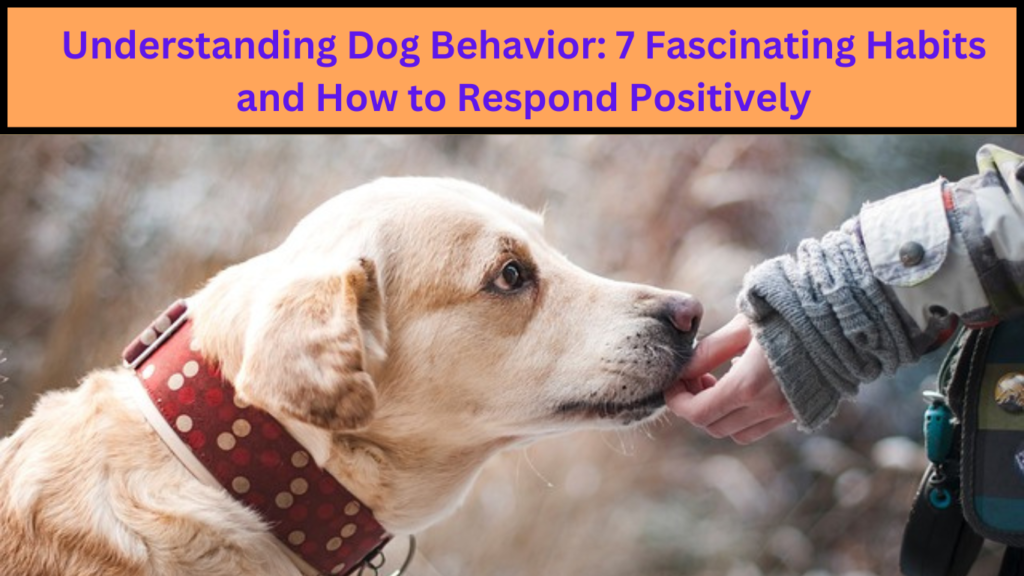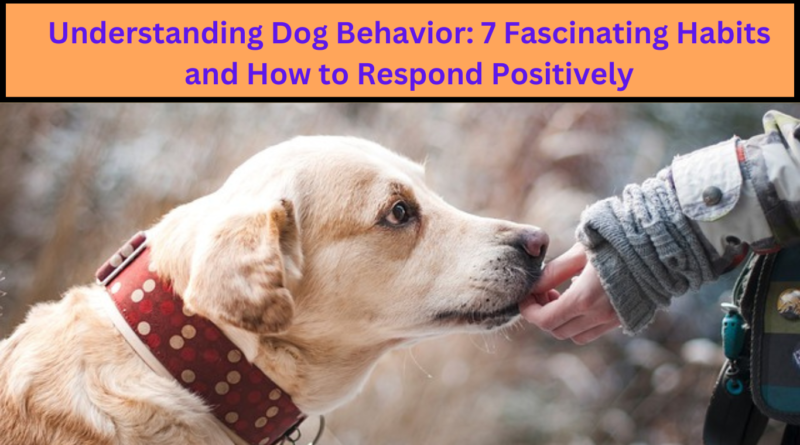Understanding Dog Behavior: 7 Fascinating Habits and How to Respond Positively
Understanding dog behavior is crucial for anyone who wants to build a strong, lasting bond with their furry friend. Dogs have been called man’s best friend for centuries, but even the most experienced dog owners sometimes find their pets’ behavior puzzling or confusing. From wagging tails to sudden barks, every gesture your dog makes is a way of communicating. By learning to read these signs, you can not only deepen your relationship with your dog but also better meet their emotional and physical needs.
In this comprehensive guide, we’ll explore 7 common dog behaviors, explain what they really mean, and provide practical tips on how to respond effectively. Along the way, we’ll touch on important concepts like canine body language, dog communication signals, and why dogs behave the way they do.

Why Is Understanding Dog Behavior So Important?
Dogs communicate primarily through body language, vocalizations, and subtle actions that are easy to overlook if you don’t know what to look for. When you understand dog behavior, you can:
- Prevent misunderstandings and potential conflicts
- Recognize signs of stress, anxiety, or illness early
- Improve training success by responding to your dog’s needs
- Strengthen trust and affection between you and your dog
For example, a wagging tail isn’t always a happy sign—sometimes it signals nervousness or alertness. Similarly, a dog that barks incessantly may be anxious or bored rather than aggressive. Knowing these nuances helps you respond with empathy, not frustration.
7 Common Dog Behavior Explained
1. Tail Wagging: More Than Just Happiness
Tail wagging is one of the most recognized canine body language signals. However, the way your dog wags their tail can mean very different things depending on the speed, height, and direction of the wag.
What It Means:
- Fast, wide wagging: Genuine excitement, joy, or eagerness. You’ll often see this when you come home or during playtime.
- Slow, stiff wagging: Hesitation, uncertainty, or mild discomfort.
- Tail tucked between legs: Fear, submission, or feeling threatened.
How to Respond:
If your dog’s tail is wagging fast and loose, it’s usually safe to engage and play. If the wag is slow or the tail is low, approach calmly and give your dog space. Avoid forcing interactions when they appear anxious.
Real-Life Example:
Imagine you bring a new friend to your home. Your dog’s tail is wagging but stiff and low—this may mean they are unsure about the visitor. Giving your dog time to sniff and adjust can prevent stress or aggression.
2. Barking: Understanding the Message Behind the Noise
Barking is one of the primary vocal ways dogs communicate. But not all barking is created equal, and understanding its context is vital.
Types of Barking:
- Excited Barking: Quick barks mixed with playful behavior; often during greetings or playtime.
- Alert Barking: Sharp, repetitive barks warning of strangers or unusual activity.
- Demand Barking: Used to get your attention for food, play, or going outside.
- Anxious Barking: Continuous, high-pitched barking due to stress, such as separation anxiety.
How to Respond:
- Identify what’s causing the barking—can you remove the trigger?
- For alert barking, calmly acknowledge the sound and then give a “quiet” command with a treat reward.
- Avoid rewarding demand barking by only responding when your dog is quiet.
- For anxious barking, consider calming strategies like crate training, puzzle toys, or consulting a professional.
Dog Training Tips:
Use consistent commands and reward-based training to teach your dog when barking is acceptable and when it’s not.
3. Chewing: Natural Instinct or Sign of Trouble?
Chewing is a normal behavior for dogs, especially puppies, but destructive chewing can be frustrating.
Why Dogs Chew:
- Puppy Teething: Chewing helps relieve the pain of growing teeth.
- Boredom: Under-stimulated dogs chew to entertain themselves.
- Stress Relief: Chewing can calm anxious dogs.
How to Respond:
Provide a variety of chew toys and rotate them to maintain interest. Avoid punishment; instead, redirect inappropriate chewing to acceptable objects. Make sure your dog gets enough exercise and mental stimulation.
Additional Tips:
- Use deterrent sprays on furniture.
- Offer frozen chew toys to soothe teething pups.
- Establish clear rules about chewing early on.
4. Rolling in Smelly Things: Why Do Dogs Do That?
While gross to us, rolling in foul smells is an instinctive behavior inherited from wild ancestors.
Possible Reasons:
- Camouflage: Wild dogs rolled in strong scents to mask their own scent for hunting.
- Territorial Marking: Leaving scent signals for other dogs.
- Enjoyment: Some dogs just love certain smells.
How to Respond:
Train a reliable “leave it” or “come” command to interrupt this behavior. Bathe your dog with pet-safe shampoo when needed.
5. Digging: More Than Just a Mess
Digging can be natural or problematic depending on the context.
Why Dogs Dig:
- To create a cool spot.
- To hunt or bury food.
- Due to boredom or anxiety.
How to Respond:
Designate a digging spot, provide plenty of exercise, and use physical barriers to protect gardens. Reward your dog for digging in the correct area.
6. Head Tilting: Cute or Communicative?
Dogs tilt their heads often when curious or trying to hear better.
What It Means:
- Curiosity or attention focus.
- Helps with sound localization.
- Shows empathy or attempts to understand.
How to Respond:
Use this opportunity to reinforce commands or praise your dog’s attentiveness.
7. Licking: Love or Something Else?
Licking is a complex behavior with multiple meanings.
Possible Meanings:
- Affection or bonding.
- Submission to a dominant dog or person.
- Exploration or taste.
How to Respond:
Reward gentle licking but redirect excessive licking with toys or commands. Watch for signs of compulsive licking which may indicate stress.
Additional Tips for Understanding Dog Behavior
- Observe Full Body Language: Look beyond one behavior to understand your dog’s mood.
- Be Consistent: Clear and consistent training yields the best results.
- Meet Physical and Mental Needs: A well-exercised and mentally stimulated dog is less likely to develop problem behaviors.
- Create a Stable Routine: Dogs feel secure when they know what to expect.
- Socialize Your Dog: Exposure to different people, animals, and environments builds confidence.
- Seek Professional Help: If certain behaviors persist or escalate, consult a vet or behaviorist.
Common Myths About Dog Behavior Debunked
- Myth: A wagging tail always means a happy dog.
Fact: Tail position and speed matter—a tucked tail signals fear. - Myth: Dogs bark only to be aggressive.
Fact: Barking can express many emotions, including excitement and anxiety. - Myth: Dogs chew to be destructive on purpose.
Fact: Chewing is often a natural or stress-relief behavior.
FAQs About Understanding Dog Behavior
Q: How can I tell if my dog is anxious or just excited?
A: Look for accompanying signs like pacing, panting, and body posture. An anxious dog might avoid eye contact and have a tucked tail.
Q: Is it normal for dogs to dig at night?
A: Some dogs dig to create a comfortable spot to sleep. If it becomes excessive, consider whether your dog is bored or stressed.
Q: Can I train my dog not to bark?
A: Yes, with patience and consistent training using commands and positive reinforcement.
Final Thoughts: Embrace the Journey of Understanding Your Dog
Understanding dog behavior is a lifelong journey that rewards patience, observation, and love. Every bark, lick, wag, or tilt is a way your dog communicates their feelings and needs. By learning to read and respond to these signals, you build a foundation of trust that leads to a happy, balanced, and joyful relationship.
Remember, your dog isn’t just a pet—they are a family member trying their best to communicate. The more you invest in understanding dog behavior, the more fulfilling your companionship will become.

